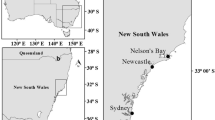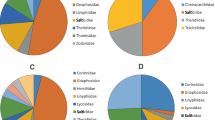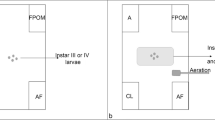Abstract
The Apteropanorpidae is a small family of scorpionflies endemic to Tasmania. The biology of the family is almost completely unknown. Here we present results of laboratory and field studies of the diet and feeding behavior of adult Apteropanorpidae. We describe the morphology of the alimentary canal and mouthparts and discuss the relationship between diet, feeding behavior and morphology. We compare these results to the feeding ecology of other extant Mecoptera, and speculate on the feeding strategies of fossil Mecoptera, placing all data in a phylogenetic context. Results show that adult Apteropanorpidae are most likely saprophagous in nature, predominantly on dead and decaying invertebrates.
Similar content being viewed by others
References
Alcock, J. (1979). Selective mate choice by females of Harpobittacus australis (Mecoptera: Bittacidae). Psyche 86: 213–217.
Bornemissza, G. F. (1966). Observations on the hunting and mating behaviour of two species of scorpion flies (Bittacidae: Mecoptera). Aust. J. Zool. 14: 371–382.
Bush, G. L. (1967). The comparative cytology of the Choristidae and Nannochoristidae (Mecoptera). Am. Philos. Soc. Yearb. 1966: 326–328.
Byers, G. W. (1963). The life history of Panorpa nuptialis (Mecoptera: Panorpidae). Ann. Entomol. Soc. Am. 56: 142–149.
Byers, G. W. (1971). Ecological distribution and structural adaptation in the classification of Mecoptera. In Proceedings of the XIII International Congress of Entomology, 2–9 August 1968, Vol. 1, pp. 486.
Byers, G. W. (1991). Mecoptera (Scorpion-flies, hanging-flies). In CSIRO (ed.), The Insects of Australia: A Textbook for Students and Research Workers, 2nd ed., Melbourne University Press, Melbourne, pp. 696–704.
Byers, G. W. (1997). Biology of Brachypanorpa (Mecoptera: Panorpodidae). J. Kans. Entomol. Soc. 70(4): 313–322.
Byers, G. W., and Thornhill, R. (1983). Biology of the Mecoptera. Ann. Rev. Entomol. 28: 203–228.
Byers, G. W., and Yeates, D. K. (1999). A second species of Apteropanorpa Carpenter from Tasmania (Mecoptera: Apteropanorpidae). Aust. J. Entomol. 38: 60–65.
Campbell, F. L. (1929). The detection and estimation of insect chitin; and the irrelation of “chitinisation” to hardness and pigmentation of the cuticula of the American cockroach, Periplaneta americana L. Ann. Entomol. Soc. Am. 22: 401–426.
Carpenter, F. M. (1930). The lower Permian insects of Kansas. Pt. 1. Introduction and the order Mecoptera. Bull. Mus. Comp. Zool. Harv. Univ. 70: 69–101.
Carpenter, F. M. (1941). A new genus of Mecoptera from Tasmania. Pap. Proc. R. Soc. Tasmania 1940: 51–53.
Carpenter, F. M. (1953). The biology of Brachypanorpa (Mecoptera). Psyche 60: 28–36.
Cooper, K. W. (1974). Sexual biology, chromosomes, development, life histories and parasites of Boreus, especially of B. notoperates. A southern California Boreus. II. (Mecoptera: Boreidae). Psyche 81: 84–120.
Crane, P. R., Friis, E. M., and Pedersen, K. R. (1995). The origin and early diversification of angiosperms. Nature 374: 27–33.
Curtis, W. M. (1956). The Students Flora of Tasmania. Part 1, Government Printer, Hobart.
Evans, J. W. (1942). A mecopterous larva from Tasmania and notes on the morphology of the insect head. Pap. Proc. R. Soc. Tasmania 1941: 31–35.
Gridley, M. F. (1953). A stain for fungi in tissue sections. Am. J. Clin. Pathol. 23: 303–307.
Hepburn, H. R. (1969). The proventriculus of Mecoptera. J. Geor. Entomol. Soc. 4(4): 159–167.
Hetrick, L. A. (1935). The morphology of the head of the scorpionfly (Panorpa nuptialis Gerst.) (Mecoptera). Proc. Louis. Acad. Sci. 2: 113–120.
Kaltenbach, A. (1978). Mecoptera (Schnabelhafte, Schnabelfliegen). Hand. Zool. 4(2)2/28: 1–111.
Kirkpatrick, J. (1997). Alpine Tasmania: An Illustrated Guide to the Flora and Vegetation, Oxford University Press, Melbourne.
Kukalová-Peck, J. (1991). Fossil history and the evolution of hexapod structures. In CSIRO (ed.), The Insects of Australia: A Textbook for Students and Research Workers, 2nd edn. Melbourne University Press, Melbourne, pp. 141–179.
Labandeira, C. C. (1997). Insect mouthparts: Ascertaining the paleobiology of insect feeding strategies. Ann. Rev. Ecol. Syst. 28: 153–193.
Labandeira, C. C., Beall, B. S., and Hueber, F. M. (1988). Early insect diversification: Evidence from a Lower Devonian bristletail from Quebec. Science 242: 913–916.
Labandeira, C. C., and Sepkoski, J. J., Jr. (1993). Insect diversity in the fossil record. Science 261: 310–315.
Miyaké, T. (1912). The life-history of Panorpa klugi McLachlan. J. Agric. Imp. Univ. Tokyo 4(2): 117–138.
Miyaké, T. (1913). Studies on the Mecoptera of Japan. J. Agric. Imp. Univ. Tokyo 4(6): 265–400.
Mochizuki, A. (1998). Characteristics of digestive proteases in the gut of some insect orders. Appl. Entomol. Zool. 33(3): 401–407.
Palmer, C. M., Siebke, K., and Yeates, D. K. (2004). Infrared video thermography: A technique for assessing cold adaptation in insects. BioTechniques 37(2): 212–217.
Peña, G. L. E. (1968). Natural history notes on Notiothauma. Discovery 4(1): 43–44.
Penny, N. D. (1977). A systematic study of the family Boreidae (Mecoptera). Univ. Kans. Sci. Bull. 51(5): 141–217.
Pinto, I. D. (1972). Permian insects from the Paraná Basin, south Brazil I. Mecoptera. Rev. Bras. de Geociências 2: 105–116.
Post, E. E., and Laudermilk, J. D. (1942). A new microchemical reaction for cellulose. Stain Tech. 17(1): 21–24.
Potter, E. (1938). The internal anatomy of the order Mecoptera. Trans. R. Entomol. Soc. London 87(20): 467–501.
Riek, E. F. (1953). Fossil mecopteroid insects from the Upper Permian of New South Wales. Rec. Aust. Mus. 23: 55–87.
Riek, E. F. (1970). Mecoptera (Scorpion-flies). In CSIRO (ed.), The Insects of Australia: A Textbook for Students and Research Workers, Melbourne University Press, Melbourne, pp. 636–646.
Russell, L. K. (1979). A new genus and a new species of Boreidae from Oregon (Mecoptera). Proc. Entomol. Soc. Wash. 81(1): 22–31.
Russell, L. K. (1982). The life history of Caurinus dectes Russell, with a description of the immature stages (Mecoptera: Boreidae). Entomol. Scand. 13: 225–235.
Setty, L. R. (1931). The biology of Bittacus stigmaterus Say (Mecoptera, Bittacusidae). Ann. Entomol. Soc. Am. 24: 467–484.
Sukatsheva, I. D. (1990). Scorpion flies. Panorpida. In Rasnitsyn, A. P. (ed.), Late Mesozoic insects of eastern Transbaikalia. Trans. Paleontol Inst. 239: 88–94.
Sukatsheva, I. D., and Rasnitsyn, A. P. (1992). First members of the family Boreidae (Insecta, Panorpida) from the Upper Jurassic of Mongolia and the Lower Cretaceous of Trans. Paleontol. J. 26(1): 168–172.
Thornhill, R. (1976). Sexual selection and nuptial feeding behaviour in Bittacus apicalis (Insecta: Mecoptera). Am. Nat. 110: 529–548.
Thornhill, R. (1977). The comparative predatory and sexual behavior of hanging-flies (Mecoptera: Bittacidae). Occ. Pap. Mus. Zool. Univ. Mich. 677: 1–43.
Thornhill, R. (1979). Male pair-forming hormones in Panorpa scorpion flies (Mecoptera: Panorpidae). Environ. Entomol. 8: 886–888.
Thornhill, R. (1980). Competition and coexistence among Panorpa scorpion flies (Mecoptera: Panorpidae). Ecol. Monogr. 50(2): 179–197.
Van Geel, B. (2001). Non-pollen palynomorphs. In Smol, J. P., Birks, H. J. B., and Last, W. M. (eds.), Tracking Environmental Change Using Lake Sediments. Volume 3: Terrestrial, Algal, and Siliceous Indicators, Kluwer Academic Publishers, Dordrecht, pp. 99–119.
Whiting, M. F. (2002). Mecoptera is paraphyletic: Multiple genes and phylogeny of Mecoptera and Siphonaptera. Zool. Scripta 31: 93–104.
Wigglesworth, V. B. (1972). The Principles of Insect Physiology, 7th edn., Chapman and Hall, London.
Willmann, R. (1989). Evolution und phylogenetisches system der Mecoptera (Insecta: Holometabola). Abh. senckenberg. naturforsch. Ges. 544: 1–153.
Author information
Authors and Affiliations
Corresponding author
Rights and permissions
About this article
Cite this article
Palmer, C.M., Yeates, D.K. Diet and Feeding Behavior in Adults of the Apteropanorpidae (Mecoptera). J Insect Behav 18, 209–231 (2005). https://doi.org/10.1007/s10905-005-0476-9
Received:
Revised:
Issue Date:
DOI: https://doi.org/10.1007/s10905-005-0476-9




